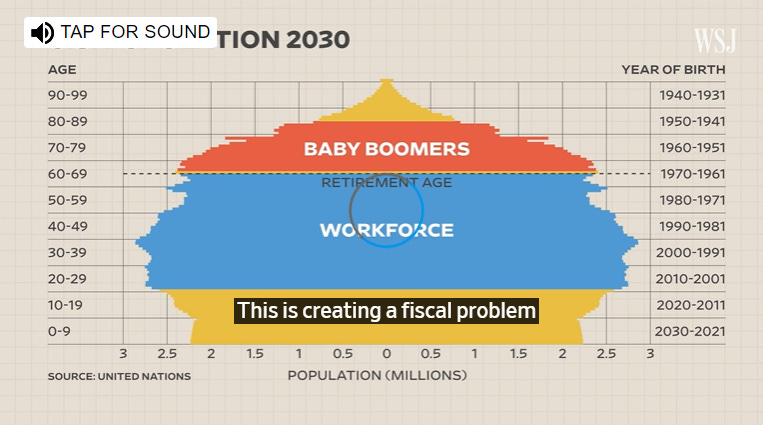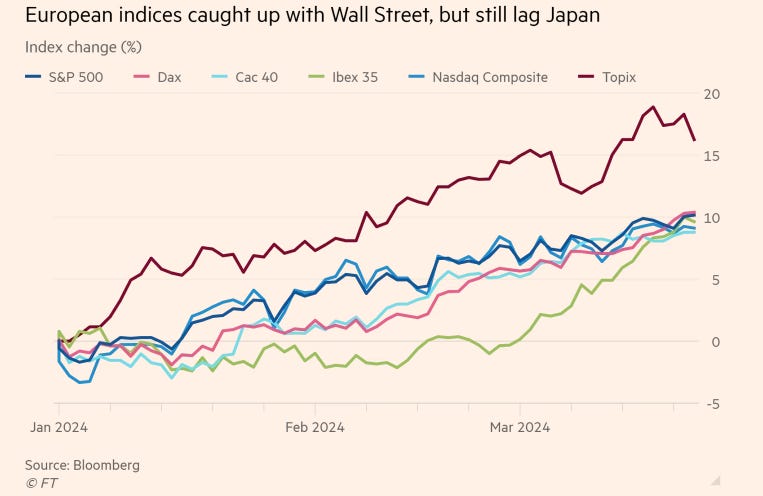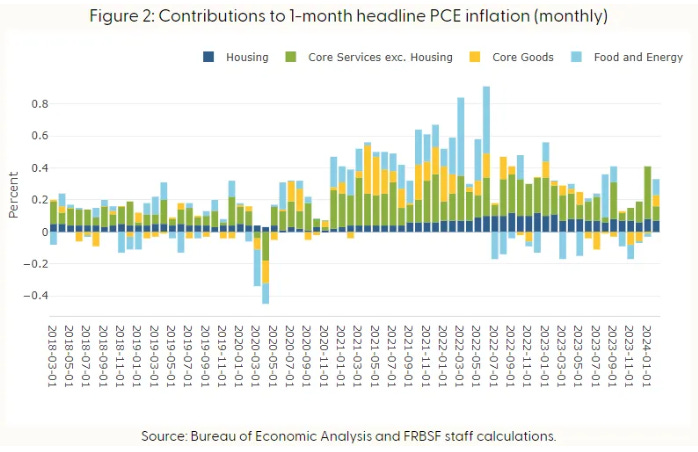Weekly Good Reads: 5-1-1
Broadening Stock Rally, US Consumer Spending, Climate Change Support, Healthier Diets, Social Security
Welcome to Weekly Good Reads 5-1-1 by Marianne O, a 25-year investment practitioner and the author of
on investing, economy, and wellness in an intuitive voice. All the Weeklies are here, and here is the index of charts and terms. You can easily subscribe to my newsletter by clicking below.Please also check out my conversations with Female Fund Managers and Investors - new this year!
Thank you so much for your support🙏.
Market and Data Comments
This has been a short and data-light week, and stocks continued their rally, with gains broadening to Europe and Japan (see Econ/Invest. #3 and chart above), supported by declining volatility in the bond market (MOVE index down 5.1 points this week).
YTD, Japan (Nikkei) (30.0%) and Italy (12.3%) beat the S&P 500 price returns (10.2%) in USD terms. [Note the best market this year is Nairobi (Kenya) which jumped 48.8% in USD terms, thanks to the recovering Shilling currency!]
The MSCI All-Country World Index rose 7.8% YTD, the most since 2019, with stocks outperforming bonds by the biggest margin in any quarter since 2020. The European economies appear to be exiting the slump with the latest Economic Sentiment Indicator (including consumer confidence) up 0.8% to 96.3. Higher real incomes can sustain higher consumer expenditure and therefore stronger growth.
The February US headline PCE and core PCE inflation slowed to 0.3% mom (lower-than-expected) and 2.5% and 2.8% yoy respectively. The most bullish inflation news relates to the core services excluding housing rents, the Fed’s preferred “supercore” inflation gauge, which rose “just” 0.2% mom in February (vs. 0.7% in January) and 3.3% yoy. As from the chart below, core services ex-housing has been the largest contributor to inflation in the US.
More importantly, personal income rose 0.3% in February (vs. 1% in January), real personal spending jumped 0.4% (concentrated in motor vehicles and transportation) while the personal savings rate fell to 3.6%, indicating inflation cooled while real spending concentrated in the upper end of earners. Atlanta Fed GDPNow tracks Q1 real GDP at 2.3% (as of March 29, quarterly % change, annualized), helped by higher real personal consumption expenditure. The US March University of Michigan consumer sentiment survey showed the highest reading in 3 years at 79.4.
Recently, Fed Powell reiterated they are not in a hurry to cut interest rates while he also expected the Fed to ease policy sometime this year. However, with the wealth increase in stock, bond, and crypto markets since October 2023, some argue for “one cut and done” as rising wealth could contribute to higher inflation.
The fact that the US economy is growing at such a solid pace, the fact that the labor market is still very, very strong, gives us the chance to just be a little more confident about inflation coming down before we take the important step of cutting rates.~ Fed Chairman Powell
Looking at the latest San Francisco Fed Data Explorer relating to US labour flow data, it is interesting to note the unemployed-to-employed flow rate (6m moving average) shows diverging trends between the 55 plus (rapidly declining) and the 25-54 age group (rising). In recessions, typically all 4 series tend to fall, probably due to the employed staying in their jobs with less turnover.

How about this one on the Median Weekly Earnings trend? The one for the age group 16-24 is stalling while the 55+ is still trending up.

This coming week, we will monitor the US March ISM manufacturing index on Monday, the March non-farm payrolls, unemployment rate and average hourly earnings on Friday, the Euro area March manufacturing PMI on Tuesday and Euro Area March preliminary inflation on Wednesday, and China’s March NBS manufacturing PMI and Caixin manufacturing PMI on Sunday and Monday.
Economy and Investments (Links):
Fed’s Preferred Inflation Metric Cools While Spending Rebounds (Bloomberg or via Archive)
What an All-Too-Quiet Stock Market Means for Future Gains (Barron’s or via Archive)
AI Boom Drives Global Stock Markets to Best First Quarter in 5 Years (FT)
Surging asset prices also reflect investors’ growing appetite for risk. In a single day in January, Nvidia’s market capitalisation rose by about $277bn — roughly equivalent to the market value of every listed company in the Philippines, according to HSBC. A 60 per cent rally over the past three months, meanwhile, has pushed the total value of existing bitcoin above the gross domestic product of about 150 countries.~FT
Finance/Wealth (Link):
20 Terms To Help Improve Your Financial Literacy (Humphreys Group)
Financial literacy [is defined] as a complex concept, encompassing multiple aspects relating to how individuals manage their resources and engage in financial decision-making.”…The Milken Institute reported that their analysis painted a worrisome picture and showed that many Americans, regardless of age, lack the basic skills and knowledge required to engage in “sound financial decision-making.”
+ Larry Fink’s 2024 Annual Chairman’s Letter to Investors - Time to Rethink Retirement (BlackRock)
Or rather than pushing back when people receive retirement benefits, perhaps there’s a more politically palatable idea: How do we encourage more people who wish to work longer with carrots rather than sticks? What if the government and the private sector treated 60-plus year-olds as late-career workers with much to offer rather than people who should retire? ~Larry Fink
Wellness/Idea (Link)
In conclusion, for middle-aged adults in the United Kingdom, sustained dietary improvement is predicted to increase life expectancy by about 3 years for both females and males. Importantly, for those with the least healthy dietary patterns, change to the longevity-associated dietary pattern is predicted to translate into approximately 10 years gain in life expectancy. Changing from an unhealthy dietary pattern to eating in line with the Eatwell Guide was associated with an 8 year life expectancy gain. Gains in life expectancy are lower the longer the delay in the initiation of dietary improvements, but even for those initiating dietary change at age 70 years, the gain in life expectancy is about half of that achieved by 40-year-old adults. The biggest gains in life expectancy are associated with increased intake of whole grains and nuts, and with reduced intake of sugar-sweetened beverages and processed meats.
+ The Stories That Become History (The Looking Glass substack) - a delightful read of several women in tech and their impact on Julie 👍!
One Chart You Should Not Miss: More People Support Climate Change Policy (Than You Think)
The majority of the world thinks climate change is a problem and supports policy to tackle it. Governments should not underestimate this support to take action.
As mentioned in Our World in Data, “Nature Climate Change found similarly high support for political change. Peter Andre et al. (2024) surveyed almost 130,000 individuals across 125 countries. 89% wanted to see more political action. 86% think people in their country “should try to fight global warming” and 69% said they would be willing to contribute at least 1% of their income to tackle climate change.”

One Term To Know: Social Security
The US government enacted the Social Security Program in 1935, paying retirement benefits and disability income to qualified retirees, their spouses, children, and survivors.
The beginning age to receive social security is 62, while the amount of benefits steps up until the full benefit amount is received at age 70. Workers must have income for at least 11 years to qualify. Their spouses (if they don’t qualify for social security themselves) can receive half of the worker’s monthly benefits.
Currently, about 73 million Americans receive social security. As of 2024, the maximum monthly benefits range from $2710 (for age 62) to $4873 (for age 70). The payout is based on the average indexed earnings during the highest 35 of your earning years.
According to the video below, 2024 will see the largest number of Americans (over 4 million) reaching retirement age, while at the same time, the US birthrate has been trending down, meaning fewer younger people are contributing to social security taxes. The Baby Boomers have been the biggest contributors to social security revenue, so revenue has been exceeding payout, and IOUs were issued to the Federal Government (in the form of Trust Fund Reserves). By 2034, the Trust Fund Reserves will run out, so Americans will not be able to receive their full benefits. About 60% of Americans rely on social security benefits for retirement.
Given Social Security is the biggest program in the Federal Budget (about 20% of the total), social security deficits will push the government to borrow more unless taxes are raised, benefits are cut, or some other Federal Programs are cut back (or a combination of these); or as Larry Fink said above, people retire later.
(Click on the picture to view the video.)

Please do not hesitate to get in touch if you have any questions!
Check out also my Conversations with Female Investors and other changemakers.
I also wrote a wellness piece lately 😊.
If you like this Weekly, please share it with your friends or subscribe to my newsletter🤝.










